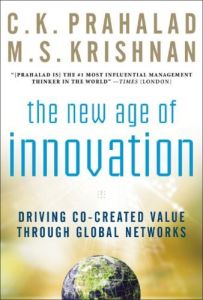Join getAbstract to access the summary!

Join getAbstract to access the summary!
C. K. Prahalad and M. S. Krishnan
The New Age of Innovation
Driving Co-created Value Through Global Networks
McGraw-Hill, 2008
What's inside?
The old lines are blurring – between products and services, hardware and software, and even executives and employees.
Recommendation
Unlike many books on new economies or global changes, this work cites examples from around the world. C. K. Prahalad and M. S. Krishnan provide illustrative case studies from firms in India, Canada, the United States, Europe and elsewhere. They examine the various interactions among these firms and locales, grounding their theoretical discussions in reality. To add even more clarity, they also include many drawings and charts; unfortunately, these tend to force a simplistic Cartesian graphing system onto complex changes. Likewise, their abbreviations are more memorable than clear. Overall, though, these are minor glitches in an innovative and useful study. The authors’ analyses of how firms are interacting internationally, and redesigning themselves and the nature of business in the process, are both interesting and valuable. Its discussions of broad trends are unusually well-informed. getAbstract recommends this book to executives and others committed to keeping up with change, especially on a large, even global, scale.
Summary
About the Authors
C. K. Prahalad and M. S. Krishnan teach at the Ross School of Business at the University of Michigan. Prahalad is author of The Fortune at the Bottom of the Pyramid.


















Comment on this summary